|
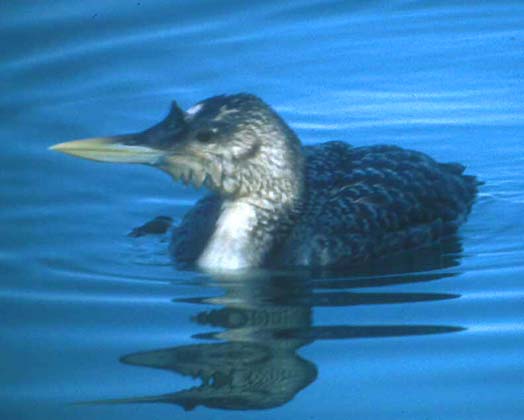 |
This Holarctic loon called "White-billed Diver" in the Old World is a rare winter visitor to Monterey Bay. Our latitude (around 36°N) is at the extreme southern edge of this loon's wintering range in "cold water" regimes. As of Apr 2004, there were 31 records for MTY. A complete set of these records follows at the bottom of this page. You'll find that half of MTY's records were tallied in the "cold water" decades that preceded the great 1982-83 El Niño and, although coverage has increased in recent decades, fewer Yellow-billed Loons have occurred in the "warm water" regimes from 1982 through 1998. One individual, though, returned for six (6) consecutive winters between 1993-1999.
|
 |
Yellow-billed Loons in juvenal plumage are large, block-headed, bill-billed,
brownish loons with prominent pale barring across the back. The bird below
bounded within purple bars is not from MTY but is an excellent illustration
of important characters. Look at these features on this juvenal bird and
on the birds above:
|
|
|
| First-year Yellow-billed Loons retain juvenal plumage through mid-winter, and retain their remiges [primaries and secondaries] until these are replaced almost simultaneously in the bird's first summer (Palmer 1962, Cramp & Simmons 1977). Late in the first winter, or in early spring, pre-alternate molt will produce fresh feathers on the body. These can be seen on this wonderful photo [below; © Stan Wulkowicz] of a mid-April bird on Elkhorn Slough [17 Apr 2004]. All the pale tips of fresh juvenal plumage have worn off leaving worn brownish back feathers, now interspersed with some new fresh Alternate I feathers on the back. These new first-alternate feathers are have thin pale tips and mid-feather pale notches rather than the broader pale tips of juvenal plumage (above). Note also that the head and neck are even more whiter now, with the auricular spot less visible [but see how differences in lighting or wetness of the feathers may affect perception of characters on two other photos of this same bird, taken 16 Apr 2004, elsewhere on this web site]. There is also a great shot of this loon on Bill Hill's web pages. |
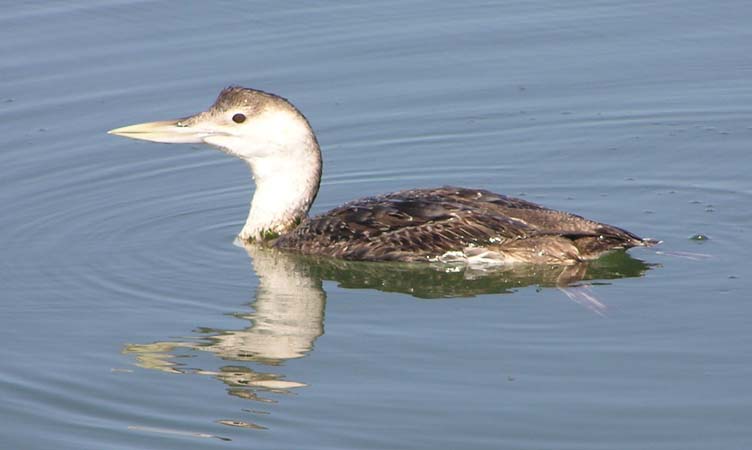 |
| Note how pale the bill of this juvenal Common Loon (below) appears.
But the distal half of the culmen [between the yellow arrowheads in the
composite to the right] is dark in Common and cleanly pale yellow in Yellow-billed.
There are a number of other bill shape differences in adult loons, detailed
in Binford & Remsen (1974), but it takes much of the first year for
the full bill shape to develop, so these are less helpful in first-year
loons. However, most Yellow-billed Loons hold their bill above the horizontal
giving an "upturned" appearance while Common Loons rarely hold their
bill this way.
photo above © Don Roberson, 28 Jan 1989 Monterey harbor |
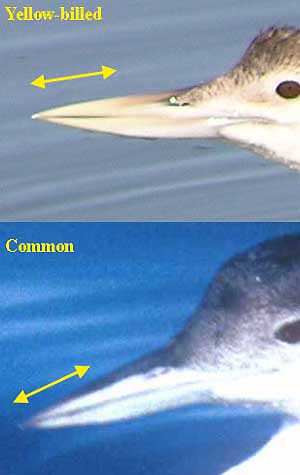 |
Two adult Yellow-billed Loons in full alternate [=breeding] plumage have visited MTY. The first, nicely described by a visiting Swede on 10 Oct 1987, is by far the earliest fall record; presumably this bird kept moving to wintering grounds somewhere to the south. The second was a bird that first appeared off Otter Pt., Pacific Grove, in juvenal plumage in Dec 1993, and then reappeared at essentially this same spot for 4 of the next 5 winters. It was not found at this site in winter 1996-1997 but an adult was off Pt. Joe that winter and might have been the same bird just a couple miles away. In most years off Otter Pt., the loon was first discovered in full alternate plumage in November but soon began a molt into basic plumage. In 1997, it was found 30 Oct and was already molting into basic by 9 Nov. The bird spent the winter in basic plumage until it began pre-alternate molt in March. It was known to linger to the last week of March in several years, and was by then back in crisp breeding dress. The set of five photos that follow are of this bird in various plumages over various years:
 |
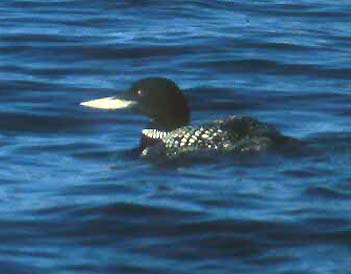 |
|
|
 |
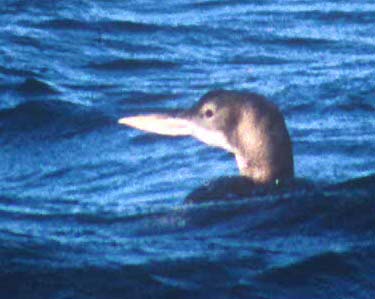 |
|
Photos right © Richard Ternullo, Jan 2001 All these photos are from boats; the bird frequented a spot about a half-mile to 1.2 mile off Otter Pt. At this distance it was rarely seen from shore so almost all of the observations were from pelagic trips. Only a very few were able to scope it from shore under ideal conditions. Note how dark the bill can appear when backlit except at the tip where the yellow color shines through. Also note that an adult in basic plumage has a darker head and neck than juvenal-plumaged birds. The adults showed a prominent white eye-ring rather than a mostly pale face. There was still a suggestion of an auricular patch but it was against a much darker background. There can be a hint of thin pale barring across the back in fresh basic plumage (above). |
 |
| Below is an interesting photo of a Yellow-billed Loon trying to take off when pressed by a boat in Monterey Bay. This bird was a half-mile west of Pt. Pinos on 5 Feb 1996. It was reported as a first-year bird and certainly the face is consistent with that plumage. I'm having trouble stating for sure whether it is in wing molt or not. The near wing suggests it is (and, if so, it must be an adult) but the far wing does not look to be in molt (and, if so, strongly suggests first-cycle bird). Whatever degree of molt or not shown here, it does illustrate just how much labor a big loon must undertake to get airborne.... Photo © L.D. Osnes-Eire. |
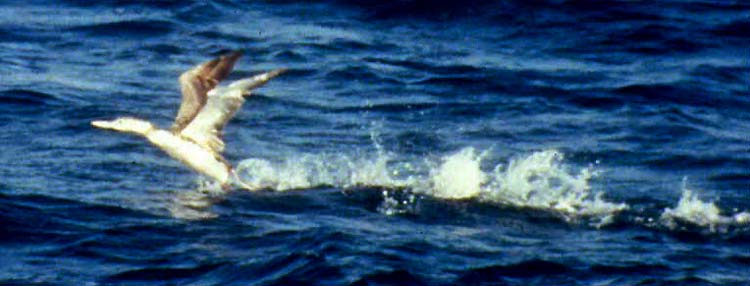 |
And now, a complete listing of all MTY records of Yellow-billed Loon:
|
rec. no. |
|
|
|
|
Location of specimen (#); if CBRC accepted so indicated with report no. in parenthesis |
| 1 | 29 Dec 1968-1 Jan 1969 | Monterey harbor | juv fem [sexed from specimen later] | Russ Greenberg & Russ Griswold; fnd dead 1 Jan | #PGMNH; CBRC accept (4) |
| 2 | 22-25 Jan 1969 | Pacific Grove (Pelagic Pt) | unk | Alan Baldridge | CBRC accept (11) |
| 3 | 29 Dec 1969 | half-mile off Pt. Joe | juv | boat trip incl. A. Baldridge & D. DeSante | CBRC accept (10) |
| 4 | 23 Jan-6 Mar 1971 | Moss Landing | juv fem [sexed from specimen] | Joe & Russ Greenberg | fnd dead 6 Mar; #MVZ; CBRC accept (6) |
| 5 | 26 Jan 1971 | Moss Landing | unk | R. Stallcup & D.A. Gaines | CBRC accept (14) |
| 6 | 21 Jan-15 Mar 1972 | Pacific Grove (Hopkins) | unk | A. Baldridge & R. Stallcup | CBRC accept (10) |
| 7 | 26 Jan-4 May 1972 | Monterey harbor | juv | G. Shum Suffel | CBRC accept(14) |
| 8 | 10 Nov 1973 | Monterey harbor | juv | L.C. Binford & J. Greenberg | CBRC accept(4) |
| 9 | 9-10 Jan 1974 | Monterey harbor | diff. juv than preceding | A. Baldridge | CBRC accept (4) |
| 10 | 24 Jan-16 Feb 1975 | Monterey harbor | unk | R.A. Erickson & G. McCaskie | CBRC accept (4) |
| 11 | 3 Jan 1976 | Monterey harbor | juv | Ted A. Chandik | CBRC accept (14) |
| 12 | 28 Apr 1976 | Monterey harbor | diff. juv than preceding | R. Stallcup | CBRCaccept (14) |
| 13 | 12 Feb 1978 | Monterey harbor | juv | S.F. Bailey & J. Van Remsen | CBRCaccept (5) |
| 14 | 23 Jan 1982 | Carmel Bay | unk | Keith Hansen | CBRC accept (11) |
| 15 | 30 Jan 1982 | Monterey harbor | unk | T.A. Chandik | CBRC accept (15) |
| 16 | 13 Jan 1985 | Pacific Grove (off Lovers Pt.) | juv | A. Baldridge | CBRCaccept (10) |
| 17 | 30 Dec 1985-19 Jan 1986 | off Moss Landing | unk | S.F. Bailey | CBRC accept (11) |
| 18 | 28 Mar 1987 | Monterey Bay (4 mi from Monterey) | prob. first-yr | Bjorn Anderson & David A. Quady & Max Perker | CBRC accept (12) |
| 19 | 10 Oct 1987 | Pacific Grove (off Otter Pt.) | adult in alt.pl. | Bengt Strigh | CBRC accept (13) |
| 20 | 24 Dec 1987 | Monterey | unk: rotting carcass | fnd dead fide A. Baldridge | skeleton #CAS; CBRC accept (13) |
| 21 | 30 Dec 1990-13 Feb 1991 | Moss Landiing | juv | Robert E. Maurer | CBRC accept (16) |
| 22 | 7-28 Dec 1993 | 1 mi off Pacific Grove (Otter Pt.) | juv | R. Ternullo & S.F. Bailey | CBRC accept (22) |
| 22 cont. | 7 Nov 1994-26 Mar 1995 | 1 mi off Pacific Grove (Otter Pt.) | adult in alternate plumage molted into basic & back into alt. pl.; considered same bird as last years juv because at same site | S.F. Bailey & R. Ternullo | CBRC accept (20) |
| 22 cont. | 10 Nov 1995-10 Feb 1996 | <1 mi off Pacific Grove (OtterPt.) | same adult as last year appeared in alt.pl. & molted into basic | R.Ternullo & D. Roberson | CBRC accept (21) |
| 22 cont. | winter 1996-97 | not found | could be #27? if so it had moved it's location | see CBRC (23) | |
| 22 cont. | 30 Oct 1997-19 Mar 1998 | <1 mi off Pacific Grove (OtterPt.) | same adult returning for 5th yr. in alt. pl. & molted into basic pl. | R. Ternullo & D.L. Shearwater | CBRC accept (23) |
| 22 cont. | 24 Nov 1998-28 Mar 1999 | <1 mi off Pacific Grove (OtterPt.) | same adult returning for 6th yr. in alt. pl. & molted into basic pl. | R. Ternullo | CBRC accept (24) |
| 23 | 12 Dec 1994-19 Mar 1995 | Monterey (Cannery Row) | juv | Jeff Bouton & S.F. Bailey | CBRC accept (20) |
| 24 | 29 Dec 1994-19 Mar 1995 | Monterey harbor vic. | juv | S.F. Bailey & D.L. Shearwater | CBRC accept (20) |
| 25 | 29 Jan 1995 | 1 mi off Ft. Ord | adult in basic pl. | R. Ternullo & S.F. Bailey & D.L. Shearwater | not reviewed by CBRC |
| 26 | 5 Feb 1996 | half-mi W of Pt. Pinos | juv ? | R. Ternullo | CBRC accept (22) |
| 27 | 11 Jan-1 Feb 1997 | 1-2 mi off Pebble Beach (Pt. Joe) | adult in basic pl. | R. Ternullo | CBRC accept (23) |
| 28 | 27 Feb 2000 | Monterey harbor | prob. juv | Brian Minshull | CBRC in circ? |
| 29 | 18 Dec 2000-15 Jan 2001 | ~1 mi off Pacific Grove (Otter Pt.) | juv; photo appears HERE | Clay Kempf | CBRC in circ? |
| 30 | 19 Jan-24 Mar 2002 | <1 mi off Pacific Grove (Otter Pt.) | juv; photo appears HERE; one reported w/o details 27 Nov 2001 could have been this same bird, seen from shore (Evelyn Meyers) | Mike Danzenbaker | CBRC in circ? |
| 31 | 15-21 Apr 2004 | Elkhorn Slough (Kirby Park) | worn juv in pre-alternate molt | Shirley Murphy | CBRC in circ |
Literature cited:
Use the following links to other portions of the MTY checklist:
Part 1: Waterfowl through Grebes
Part 2: Albatrosses through Frigatebirds
Part 3: Herons through Cranes
Part 4: Plovers through Sandpipers
Part 5: Jaegers through Alcids
Part 6: Doves through Woodpeckers
Part 7: Flycatchers through Larks
Part 8: Swallows through Pipits
Part 9: Waxwings through Warblers
Part 10: Tanagers through Sparrows
Part 11: Grosbeaks through Finches
or just the plain Checklist (no annotations)
Readers may use this material for their own private
enjoyment, study, or research but none of the photos or text herein may
be used commercially nor may they be reposted on other web sites without
written permission. All material is copyrighted. The posting of photos
and text on this private web site is not a submission to review organizations.